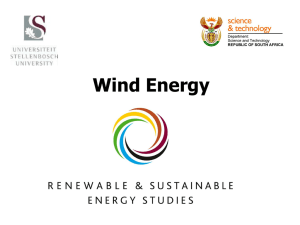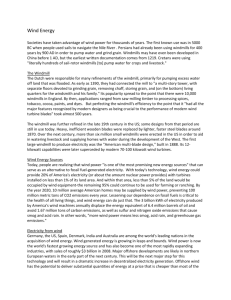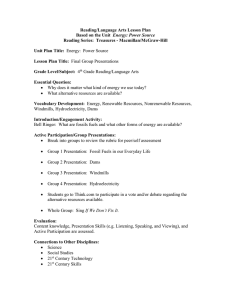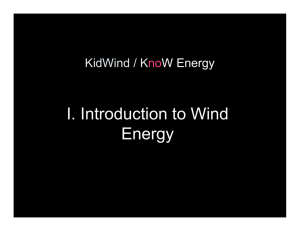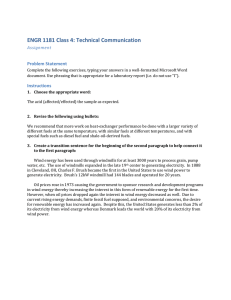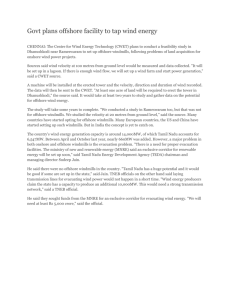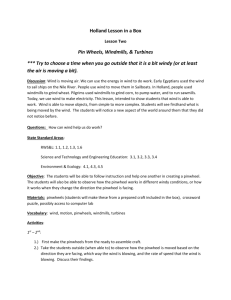Midwest's windmills generate buzz USA Today
advertisement
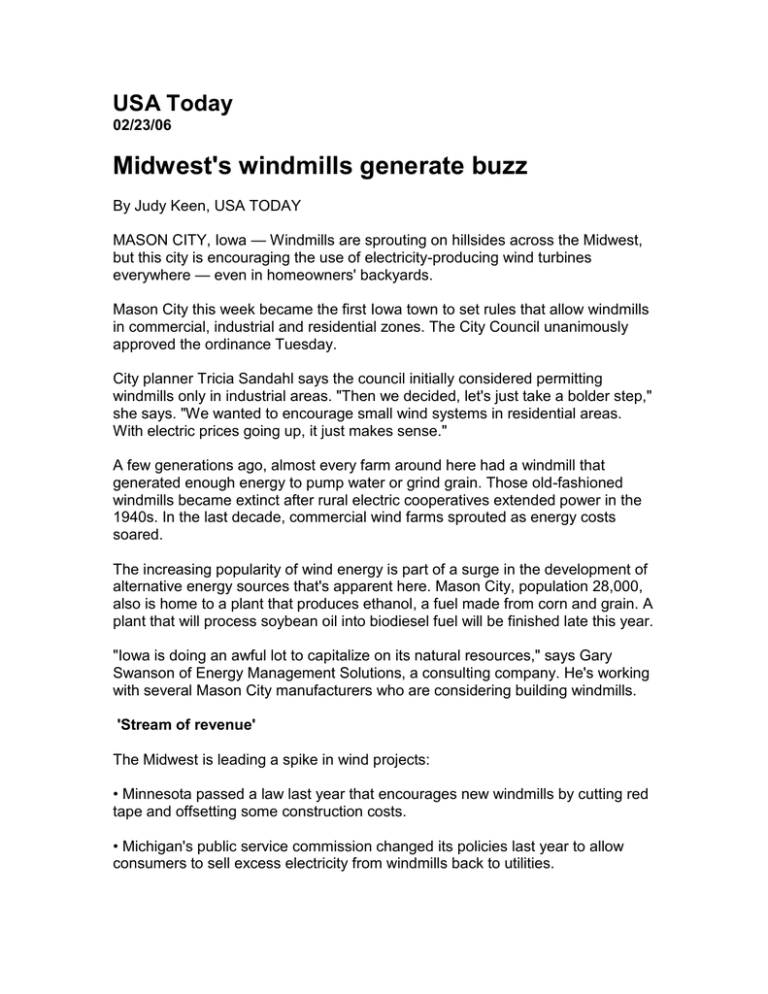
USA Today 02/23/06 Midwest's windmills generate buzz By Judy Keen, USA TODAY MASON CITY, Iowa — Windmills are sprouting on hillsides across the Midwest, but this city is encouraging the use of electricity-producing wind turbines everywhere — even in homeowners' backyards. Mason City this week became the first Iowa town to set rules that allow windmills in commercial, industrial and residential zones. The City Council unanimously approved the ordinance Tuesday. City planner Tricia Sandahl says the council initially considered permitting windmills only in industrial areas. "Then we decided, let's just take a bolder step," she says. "We wanted to encourage small wind systems in residential areas. With electric prices going up, it just makes sense." A few generations ago, almost every farm around here had a windmill that generated enough energy to pump water or grind grain. Those old-fashioned windmills became extinct after rural electric cooperatives extended power in the 1940s. In the last decade, commercial wind farms sprouted as energy costs soared. The increasing popularity of wind energy is part of a surge in the development of alternative energy sources that's apparent here. Mason City, population 28,000, also is home to a plant that produces ethanol, a fuel made from corn and grain. A plant that will process soybean oil into biodiesel fuel will be finished late this year. "Iowa is doing an awful lot to capitalize on its natural resources," says Gary Swanson of Energy Management Solutions, a consulting company. He's working with several Mason City manufacturers who are considering building windmills. 'Stream of revenue' The Midwest is leading a spike in wind projects: • Minnesota passed a law last year that encourages new windmills by cutting red tape and offsetting some construction costs. • Michigan's public service commission changed its policies last year to allow consumers to sell excess electricity from windmills back to utilities. • North Dakota last year reduced application fees and made it easier to get permission to build windmills. Lisa Daniels, executive director of Windustry, a Minneapolis-based non-profit group, says wind energy is a natural fit in rural areas. Farmers lease their land to commercial wind farms and in many states can sell back excess electricity from their own windmills. "People are seeing that it's not only good for the environment, but it's also ... a new revenue stream that fits in well with the corn and the soybeans," Daniels says. Tax credits and low-interest loans are making windmills more affordable. A small home-based system costs about $40,000. Last year, a record 9,149 megawatts of electricity was produced by wind in the USA, says Christine Real de Azua of the American Wind Energy Association, a trade group. That's just 0.5% of all electricity generated in the country, but production this year is expected to top 12,000 megawatts and keep climbing. One megawatt is enough to power 300 to 1,000 households at any one time, depending on climate and other factors. "It's possible we could generate up to 20% of our electricity needs through wind and turbine," President Bush said Tuesday at the National Renewable Energy Lab in Colorado. Marv Schlutz helped make Mason City a wind-energy pioneer. He asked the zoning board for a variance so he could put a 100-foot windmill at Mason City Warehouse, his storage business. He figured he'd save enough on electric bills to pay for a $40,000 system in eight to 10 years. "The neighbors raised heck with me," Schlutz says. They worried about whether birds could be killed by rotating blades, TV signal interruptions, interference with the local hospital's emergency helicopter and bad odors that could be sent their way. Opposition faded as gas and electricity prices kept rising. School districts in Forest City and Spirit Lake, also in northern Iowa, were using windmills to cut utility bills. The Cerro Gordo wind farm in Ventura, a few miles west of here, has 55 large turbines on 2.4 acres. Tom Hurd, a Mason City architect, installed two 35-foot-tall windmills outside his office. His windmills and solar-energy panels produce 90% of the electricity used by his company, Spatial Designs. "If the wind is 15 mph or less, you don't even hear it," he says. "Once a year you have to check whether the blades are tight, and that's all you have to do." Hindrances, ordinances There can be drawbacks. The 300-foot-tall wind turbines that stretch for miles along Altamont Pass, Calif., have been blamed for the deaths of tens of thousands of birds. Residents of Cape Cod, Mass., who oppose a proposed offshore wind farm say it would create visual pollution. Nebraska is studying whether transmission lines have to be updated to handle electricity produced by windmills, diminishing their cost-effectiveness. Mason City's ordinance requires permits for windmills and sets limits on where they can be built. Residential windmills can't exceed 100 feet tall and can be put only in backyards. The lot has to be big enough so that if the windmill topples it doesn't cross property lines. Sandahl, the city planner, says several homeowners have called to get information about installing a windmill. Bill Hammond, who manages an alternate-energy loan program at the Iowa Energy Center, a research facility at Iowa State University, predicts that more people will want windmills as they recognize the potential. "There's actually money in that wind," he says, "and people want a piece of it."
